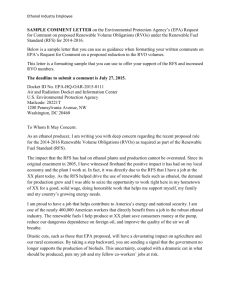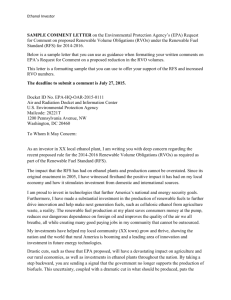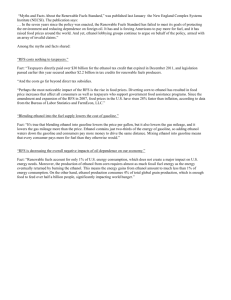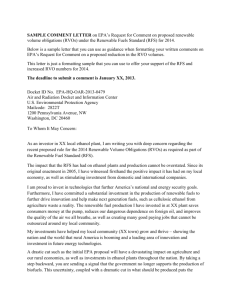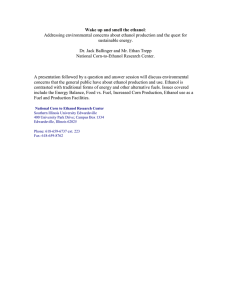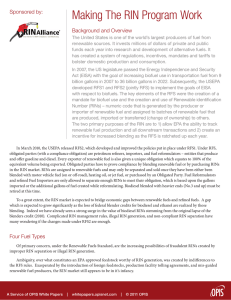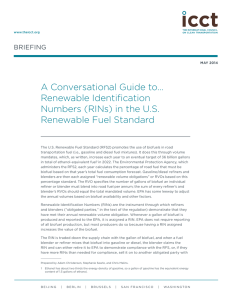The RIN Fact Sheet - Clean Fuels Development Coalition
advertisement
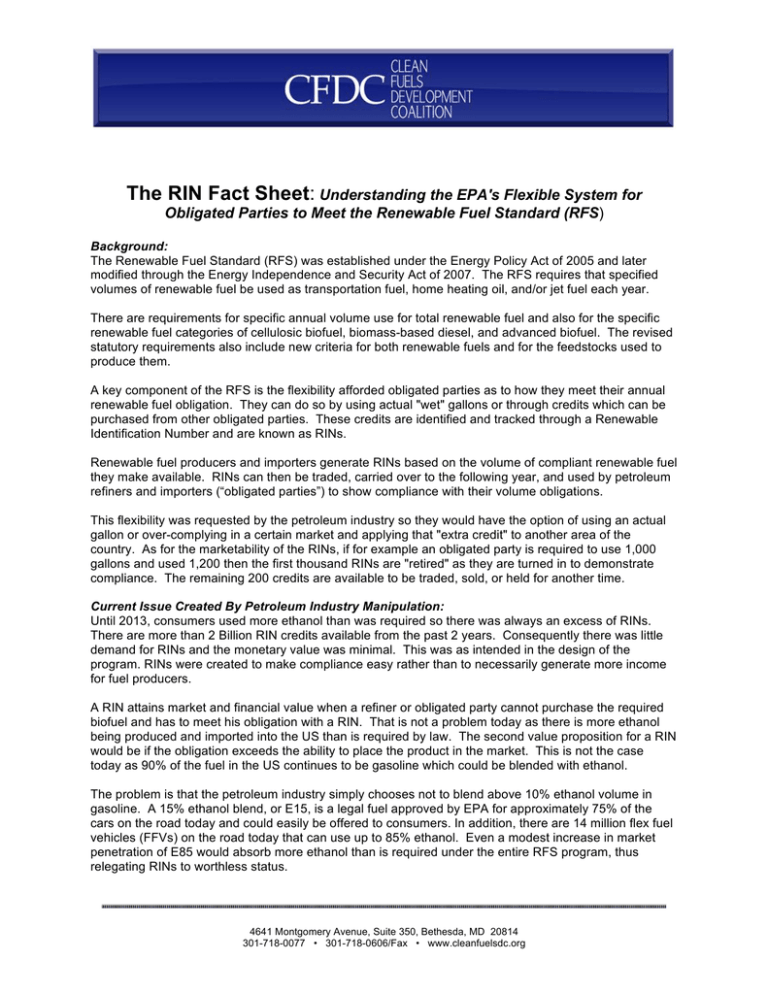
The RIN Fact Sheet: Understanding the EPA's Flexible System for Obligated Parties to Meet the Renewable Fuel Standard (RFS) Background: The Renewable Fuel Standard (RFS) was established under the Energy Policy Act of 2005 and later modified through the Energy Independence and Security Act of 2007. The RFS requires that specified volumes of renewable fuel be used as transportation fuel, home heating oil, and/or jet fuel each year. There are requirements for specific annual volume use for total renewable fuel and also for the specific renewable fuel categories of cellulosic biofuel, biomass-based diesel, and advanced biofuel. The revised statutory requirements also include new criteria for both renewable fuels and for the feedstocks used to produce them. A key component of the RFS is the flexibility afforded obligated parties as to how they meet their annual renewable fuel obligation. They can do so by using actual "wet" gallons or through credits which can be purchased from other obligated parties. These credits are identified and tracked through a Renewable Identification Number and are known as RINs. Renewable fuel producers and importers generate RINs based on the volume of compliant renewable fuel they make available. RINs can then be traded, carried over to the following year, and used by petroleum refiners and importers (“obligated parties”) to show compliance with their volume obligations. This flexibility was requested by the petroleum industry so they would have the option of using an actual gallon or over-complying in a certain market and applying that "extra credit" to another area of the country. As for the marketability of the RINs, if for example an obligated party is required to use 1,000 gallons and used 1,200 then the first thousand RINs are "retired" as they are turned in to demonstrate compliance. The remaining 200 credits are available to be traded, sold, or held for another time. Current Issue Created By Petroleum Industry Manipulation: Until 2013, consumers used more ethanol than was required so there was always an excess of RINs. There are more than 2 Billion RIN credits available from the past 2 years. Consequently there was little demand for RINs and the monetary value was minimal. This was as intended in the design of the program. RINs were created to make compliance easy rather than to necessarily generate more income for fuel producers. A RIN attains market and financial value when a refiner or obligated party cannot purchase the required biofuel and has to meet his obligation with a RIN. That is not a problem today as there is more ethanol being produced and imported into the US than is required by law. The second value proposition for a RIN would be if the obligation exceeds the ability to place the product in the market. This is not the case today as 90% of the fuel in the US continues to be gasoline which could be blended with ethanol. The problem is that the petroleum industry simply chooses not to blend above 10% ethanol volume in gasoline. A 15% ethanol blend, or E15, is a legal fuel approved by EPA for approximately 75% of the cars on the road today and could easily be offered to consumers. In addition, there are 14 million flex fuel vehicles (FFVs) on the road today that can use up to 85% ethanol. Even a modest increase in market penetration of E85 would absorb more ethanol than is required under the entire RFS program, thus relegating RINs to worthless status. 4641 Montgomery Avenue, Suite 350, Bethesda, MD 20814 301-718-0077 • 301-718-0606/Fax • www.cleanfuelsdc.org Because of the huge margins the petroleum industry realizes from refined products like gasoline, and as a way to discredit the RFS, the oil industry has elected not to blend ethanol in volumes above 10%. Instead, the oil industry has elected to meet the RFS requirement with RINs. This decision immediately raised the price of RINs. Even as a RIN has escalated from less than 10 cents to nearly $1, obligated parties can devalue the price of ethanol by amassing RINs at this price and thus control the market. Ethanol is available nationwide at an average of 70 cents per gallon less than gasoline at the wholesale level. In past years the oil industry has used this price differential for discretionary ethanol blending to take advantage of the high octane value of ethanol. Today, oil companies are not marketing ethanol on a discretionary basis in E15 or other ethanol blends despite the high potential profit. Electing this option would immediately reduce RIN values while facilitating compliance by obligated parties. The RIN hysteria generated by the media is a result of looking only at the message being conveyed by the petroleum industry, i.e. “the current volume requirement of approximately 13.8 billion gallons cannot be blended into 130 billion gallons.” As explained, this is based on obligated parties imposing a selfprescribed limit of 10% blend volume. In addition to the fact that the 10% limit does not exist except by choice, Congress intended that ethanol and a diverse variety of other biofuels would gradually be integrated into the US gasoline pool. Incremental amounts of biofuels are required each year over the next decade. Congress was fully aware that biofuel volume would not be limited to 10% volume per gallon. Congress anticipated that E85 and other ethanol/biofuel blends would move into the gasoline pool as a means of achieving cleaner, less expensive renewable fuels that strengthened the US economy while adding jobs and stimulating investment. Solution: The RIN controversy is a self-inflicted crisis contrived by the petroleum industry. The reason a requirement for renewable fuel was passed overwhelmingly by Congress – twice -- is that the petroleum industry has a monopoly on transportation fuel built on 100 years of tax incentives and preferential treatment. In fact, we have a 90% petroleum mandate today due to oil industry control of the market. The RFS was intended to move the US beyond this de facto mandate. The oil industry has had nearly seven years since the initial RFS to meet this requirement they helped negotiate. Their refusal to reduce the negative impacts of this reliance on oil by diversifying into renewables necessitates the annual RFS requirement which can be easily met. E10, E15, E85, Biodiesel, Jet Fuel, Renewable Boiler Fuel, and conversion to gaseous fuel are all available options for compliance. Each option offers consumers cleaner fuel choices and lower cost fuels. For further information please contact: Douglas A. Durante, Executive Director, Clean Fuels Development Coalition (cfdcinc@aol.com) Todd Sneller, Administrator, Nebraska Ethanol Board (todd.sneller@nebraska.gov)



